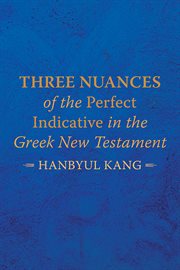Nonfiction
eBook
Details
PUBLISHED
Made available through hoopla
DESCRIPTION
1 online resource
ISBN/ISSN
LANGUAGE
NOTES
This book analyzes the existence of the three nuances of the perfect tense occurring in the Greek New Testament: resultative-stative, anterior (current relevance), and simple past. The ancient Greek perfect expresses a resultative-stative nuance, with intransitivity dominant. Some of these archaic perfects survived up to the Koine period and appear in the Greek New Testament. In Classical Greek, the perfect went through a transition from resultative to anterior (current relevance) with increasing transitivity. In the Koine period, the Greek perfect shows another semantic change from the anterior to simple past. In the end, the perfect merged with the aorist, ending up in decay. It disappeared until the modern Greek development of a perfect forming using the auxiliary ἔχω
Mode of access: World Wide Web







